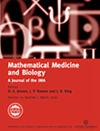非同源末端连接途径中DNA双链断裂修复的随机性影响。
IF 1.5
4区 数学
Q4 BIOLOGY
Mathematical Medicine and Biology-A Journal of the Ima
Pub Date : 2018-12-05
DOI:10.1093/imammb/dqx017
引用次数: 1
摘要
DNA双链断裂(DSBs)是电离辐射、工业化学品和各种化疗药物引起的最致命的DNA损伤。在DNA损伤反应系统建模的背景下,不确定性可能出现在几个方面,如诱导dsb的数量、动力学速率和可观察量的测量误差。因此,使用随机方法来进一步了解dsb修复过程的动态行为是必要的。本文根据DSB复杂度建立了非同源末端连接(NHEJ)机理的连续时间马尔可夫链(CTMC)模型。此外,采用Metropolis蒙特卡罗方法对动力学速率常数进行了极大似然估计。本文研究了波动动力学速率和DSBs诱导速率对NHEJ机理的影响。模拟了简单和复杂dsb连接总产率的随机实现,比较了它们的渐近动力学。此外,还证明了当dsb数量足够大时,dsb的总产率呈正态分布。为了估计dsb的预期维修时间,基于CTMC NHEJ模型计算了dsb寿命的概率分布。此外,该模型还评估了恒定低剂量辐射下dsb总产率的变异性。研究结果表明,在随机NHEJ模型中,当修复过程中没有新的dsb诱导时,所有dsb最终都被修复。然而,当持续低剂量辐射诱导dsb时,许多dsb仍未修复。本文章由计算机程序翻译,如有差异,请以英文原文为准。
The effect of stochasticity on repair of DNA double strand breaks throughout non-homologous end joining pathway.
DNA double strand breaks (DSBs) are the most lethal lesions of DNA induced by ionizing radiation, industrial chemicals and a wide variety of drugs used in chemotherapy. In the context of DNA damage response system modelling, uncertainty may arise in several ways such as number of induced DSBs, kinetic rates and measurement error in observable quantities. Therefore, using the stochastic approaches is imperative to gain further insight into the dynamic behaviour of DSBs repair process. In this article, a continuous-time Markov chain (CTMC) model of the non-homologous end joining (NHEJ) mechanism is formulated according to the DSB complexity. Additionally, a Metropolis Monte Carlo method is used to perform maximum likelihood estimation of the kinetic rate constants. Here, the effects of fluctuating kinetic rates and DSBs induction rate of the NHEJ mechanism are investigated. The stochastic realizations of the total yield of simple and complex DSBs ligation are simulated to compare their asymptotic dynamics. Furthermore, it has been proved that the total yield of DSBs has a normal distribution for sufficiently large number of DSBs. In order to estimate the expected duration of repairing DSBs, the probability distribution of DSBs lifetime is calculated based on the CTMC NHEJ model. Moreover, the variability of total yield of DSBs during constant low-dose radiation is evaluated in the presented model. The findings indicate that in stochastic NHEJ model, when there is no new DSBs induction through the repair process, all DSBs are eventually repaired. However, when DSBs are induced by constant low-dose radiation, a number of DSBs remains un-repaired.
求助全文
通过发布文献求助,成功后即可免费获取论文全文。
去求助
来源期刊
CiteScore
2.20
自引率
0.00%
发文量
15
审稿时长
>12 weeks
期刊介绍:
Formerly the IMA Journal of Mathematics Applied in Medicine and Biology.
Mathematical Medicine and Biology publishes original articles with a significant mathematical content addressing topics in medicine and biology. Papers exploiting modern developments in applied mathematics are particularly welcome. The biomedical relevance of mathematical models should be demonstrated clearly and validation by comparison against experiment is strongly encouraged.
The journal welcomes contributions relevant to any area of the life sciences including:
-biomechanics-
biophysics-
cell biology-
developmental biology-
ecology and the environment-
epidemiology-
immunology-
infectious diseases-
neuroscience-
pharmacology-
physiology-
population biology

 求助内容:
求助内容: 应助结果提醒方式:
应助结果提醒方式:


